October gardening jobs: 15 tasks to keep your plot in shape this month
These are the most important October gardening jobs to add to your to-do list for the month ahead
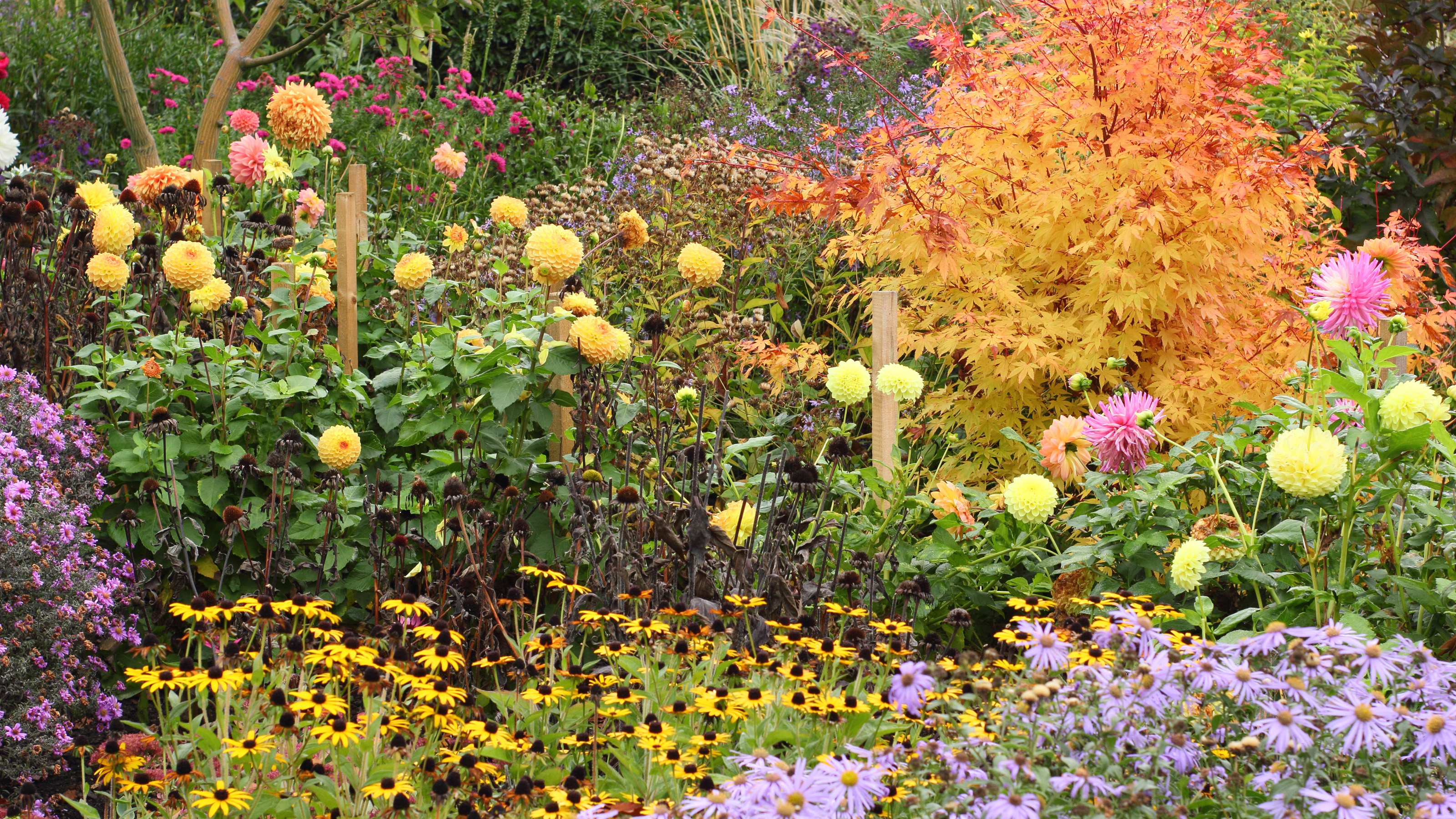

Autumn is finally upon us and the most important October gardening jobs reflect that. It’s all about preparing garden structures for winter and making sure plants are either snug undercover or able to survive the weather outside.
This is the start of the main season for taking hardwood cuttings to propagate many trees and shrubs, and we must also remember to care for houseplants too.
Many indoor plants come from temperate, tropical areas of the world and in northern climates they may suffer during the darker days of winter where there is less light and they are confined to a dry, centrally heated atmosphere.
So while non-gardeners may think we are entering a ‘quiet time’ on our plots, they couldn’t be more wrong! Below are some of the most important jobs in the monthly gardening calendar to tackle in October to keep the garden healthy and your plants happy.
Keep busy with these October gardening jobs
Get your plot tidied up and ready for the cooler weather with our list of October gardening jobs. From essential cleaning and pruning to taking cuttings and protecting pots, there's lots to keep you busy in the weeks ahead.
1. Clean and clear the greenhouse
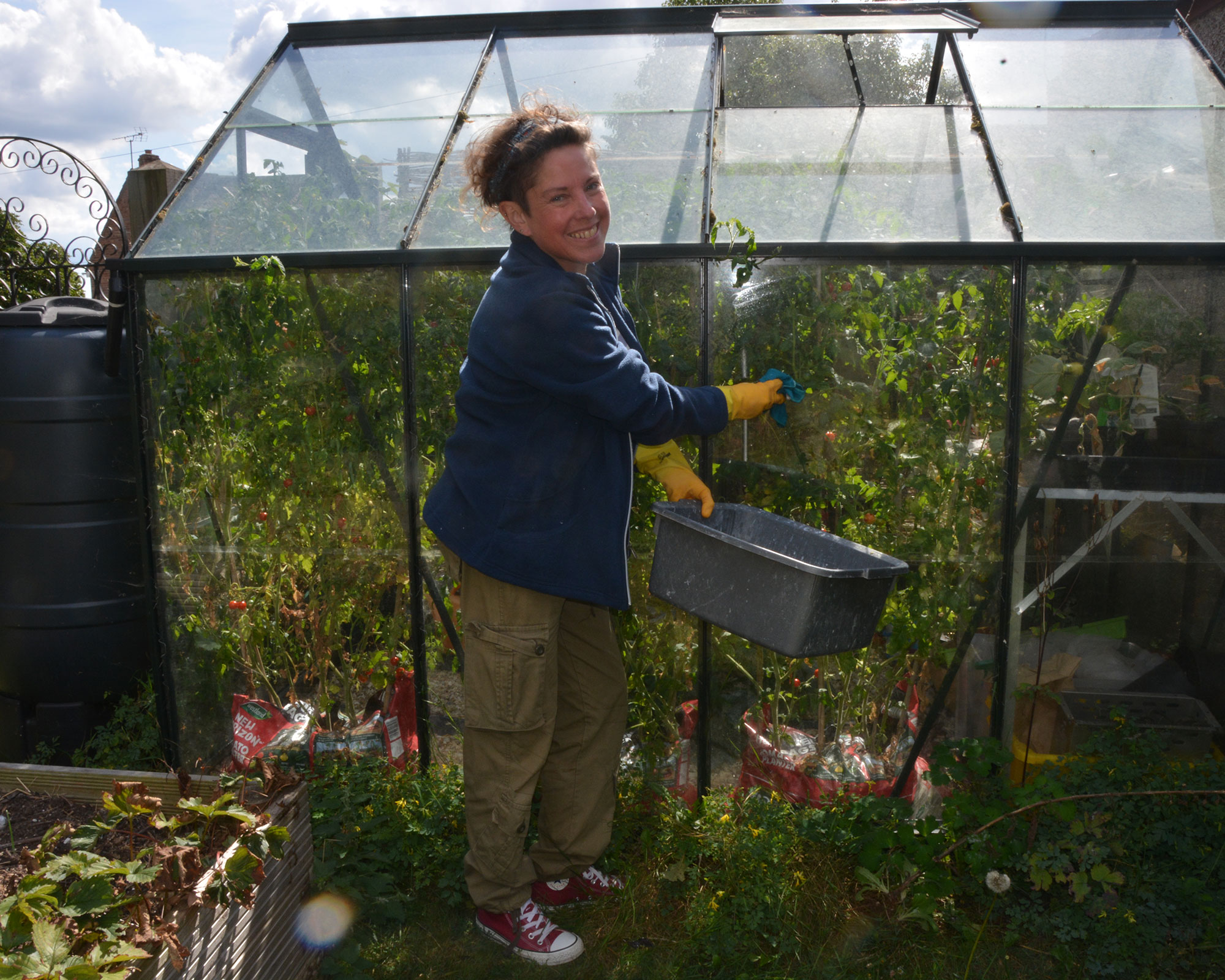
Our greenhouse has been bursting at the seams with tomatoes, courgettes and chilli plants this summer, but now the chillies have been moved indoors for winter and the tomatoes and courgettes are coming to their natural end, so it’s time to prepare the space for the winter arrivals on the greenhouse growing calendar.
Tender perennials as well as cuttings and some seedlings will find their way in there, as well as dahlia and canna tubers and begonia corms. The spent tomato and courgette plants that are not beset by diseases such as powdery mildew will head to the compost heap and the growbag compost will be added to garden borders as a soil improver. It won’t have many nutrients left but will help improve the structure and consistency of the soil. If you have soil beds in the greenhouse, weed them well and nourish with well-rotted compost and manure.
Once your greenhouse is empty, give it a thorough clean, as a grubby environment can increase the chance of overwintering plants being attacked by fungus and mildews. Wash down the glass inside and out to remove muck and algae and to let as much light inside as possible. Do the same to working surfaces, then use a flexible plastic plant label to winkle out any grime between the panes of glass.
Don’t forget to clear debris out of greenhouse gutters so rain can flow freely into water butts or rain barrels – this is an ideal time to learn how to make a rain barrel if you haven’t already done so.
Top tip: Keep a couple of growbags, and after making sure the compost doesn’t contain pests or dead plant material, enrich it with a granular fertilizer and sow some winter salad for a supply of fresh leaves through winter.
2. Look after your pots
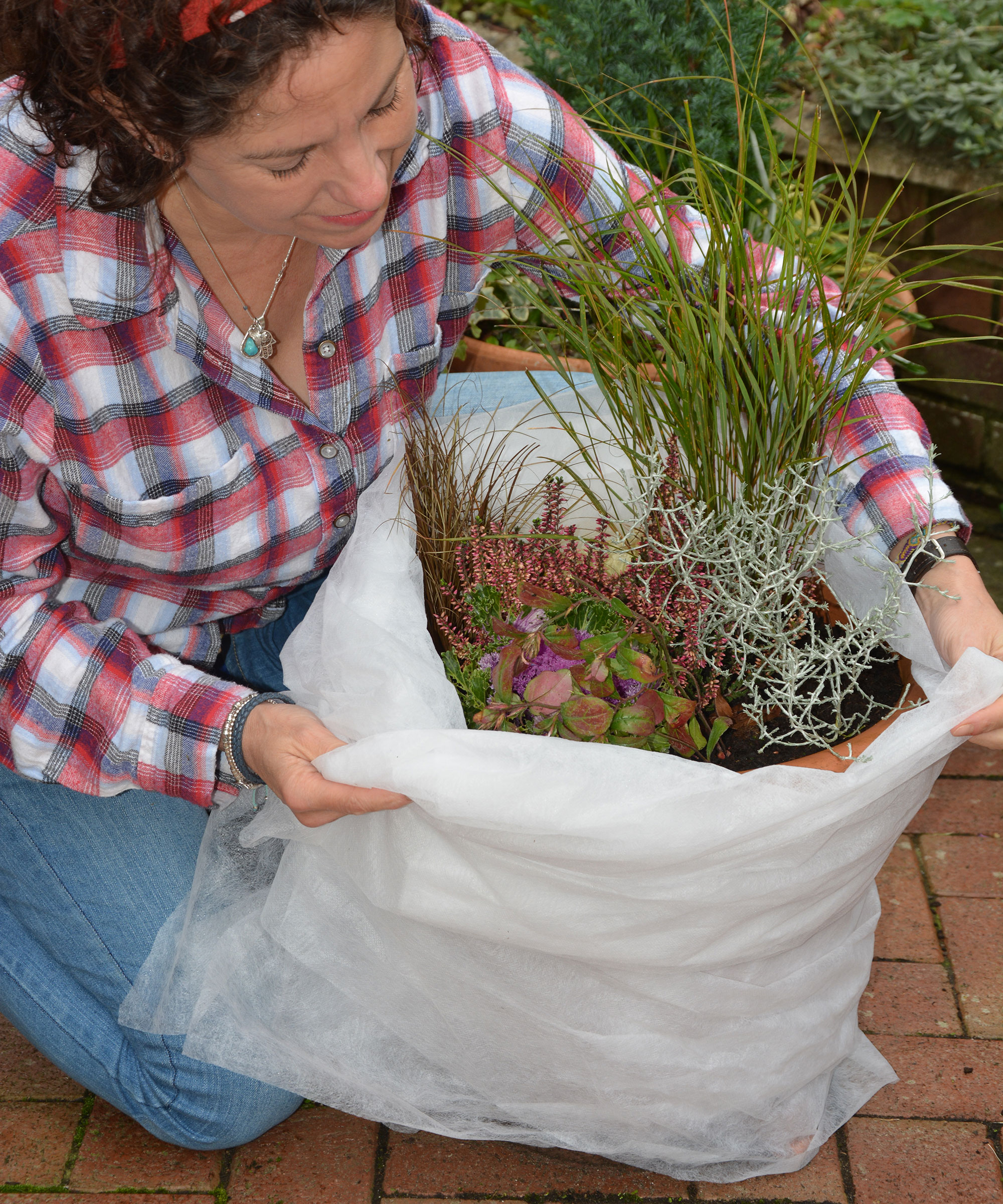
Insulating a winter planter with a layer of bubble wrap
Because of the way they are grown, close together and with finite amounts of food and water, container plants are among the most continuously vulnerable plants in the garden. In winter, they are at risk from freezing and waterlogging and in milder periods can be attacked by mold.
Here are four easy things you can do to keep your garden planters safe from adverse seasonal weather:
- One way of insulating pots so they don’t crack is to line them with bubble wrap, making sure the drainage holes are left clear.
- Use pot feet so excess water can escape and the compost won’t get waterlogged.
- Watch for slugs and snails in mild autumns and winters. Copper tape is said to deter them, but check plants regularly.
- If it gets very cold, swaddle pots in fleece and mulch the top with straw, removing it when the weather warms up.
You should also keep an eye on your hanging baskets, taking them down and storing them somewhere sheltered when storms are forecast.
Autumn and winter can be dry, so you will need to keep watering plants regularly and feeding plants until they go dormant in the depths of winter.
Top tip: Don’t overwater, especially when using peat-free compost that can look dry on top but be sopping below the surface. The symptoms of waterlogging are similar to those of drought – yellowing, wilting leaves – so if this happens, stop watering and if practical, re-pot plants in fresh compost with added grit or perlite to improve drainage.
3. Start taking hardwood cuttings

Firming in hardwood rose cuttings in the ground - they will stay here for a year
Taking cuttings from plants is one of the most reliable ways of propagating deciduous trees and shrubs, including soft fruit bushes and roses. Taken now and either potted up or grown in the ground, they will take up to a year to develop roots but then will grow into robust young plants.
Hardwood cuttings are taken in fall, when plants are dormant and their wood has matured, ripened and hardened off so it is able to withstand colder weather. They can be taken any time between now and late winter, apart from when there is a severe frost.
If you are only taking a few cuttings they can be potted up in a mix of seed and cuttings compost mixed with grit or perlite. Alternatively, insert them in a trench lined with horticultural sand in a sheltered area of the garden where they can remain without disturbance for the next 12 months.
Top tip: If you are rooting hardwood cuttings in the soil, check them after frosts as the ground may have cracked around them. If this happens, simply tread it back down so they are held firmly in the ground.
4. Keep an eye on houseplants

As light levels fall and the days shorten, most of our houseplants stop growing and settle down for their winter rest. The exception is ‘gift’ plants such as moth orchids, African violets and streptocarpus, which keep flowering through the darker months.
However, this doesn’t mean you can simply forget about your best indoor plants. While the care they need may be minimum, it is still important.
When it comes to caring for houseplants in winter, instead of watering little and often, give them a good drink then wait until the compost is almost dry to the touch before the next one. Stop feeding them unless they are flowering or in bud.
Rooms are darker at this time of year, so move plants closer to windows, but avoid leaving them on windowsills overnight, as closed curtains can trap cold air and create a chill pocket. Wiping their leaves clean of debris and dust also helps them make the most of the available sunlight and removes pests.
Position plants out of drafts and away from direct sources of heat, such as radiators. Central heating creates a dry atmosphere, which plants hate. Improve the humidity in rooms with bowls of water or by standing plants on a bed of gravel that is kept damp.
Top tip: Houseplants will repay your kindness by helping purify the air, especially important in winter when many of us live in hot homes with closed windows.
5. Protect your fruit trees
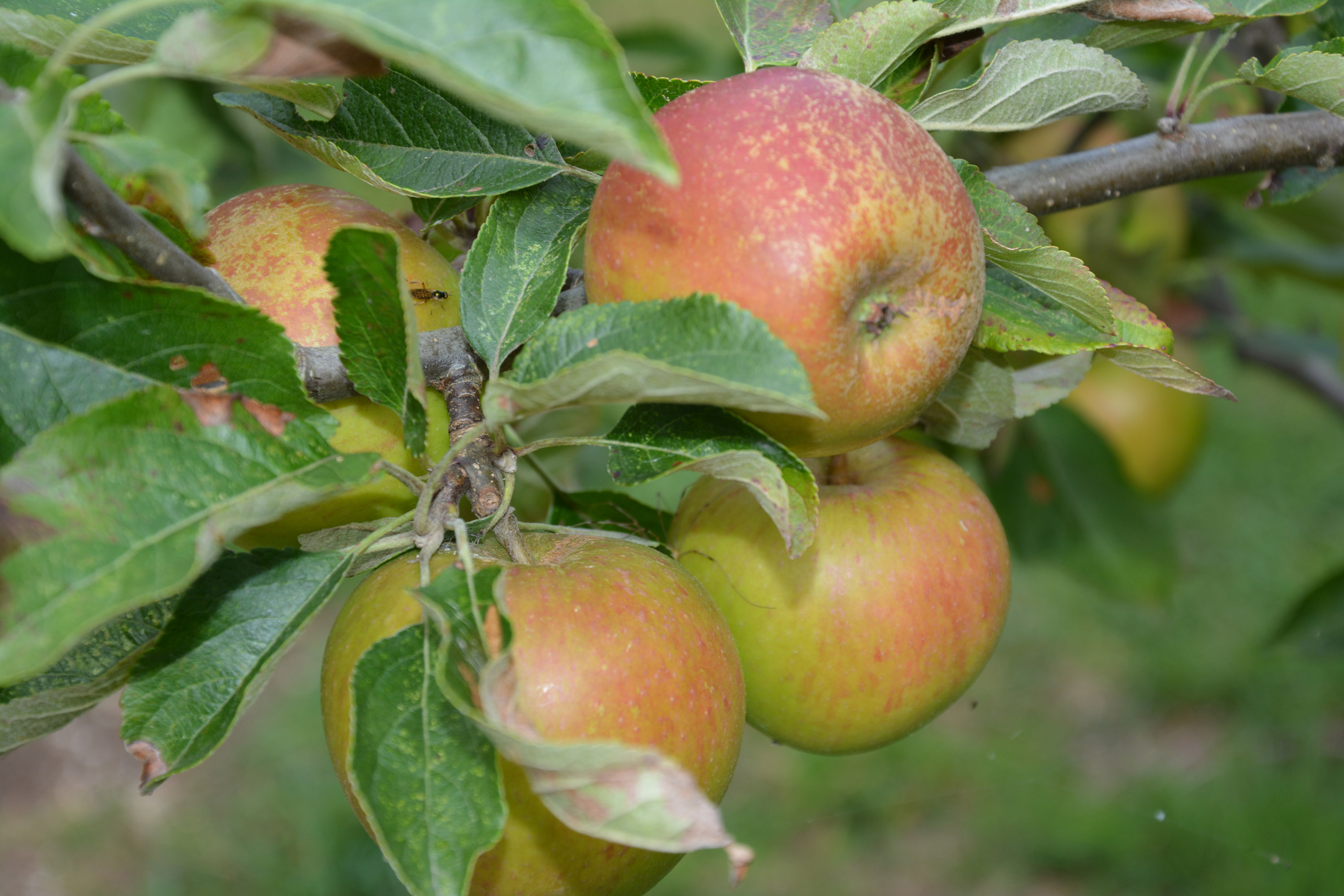
Fruit trees are vulnerable to moth attacks in the fall so need to be protected
There is a well-worn, ancient joke that goes ‘What’s even worse than biting into an apple and discovering a maggot?’ The answer, of course, is ‘discovering half a maggot’, and early autumn is the time to be taking steps to ensure that fate doesn’t befall you next summer.
Several moths, including the winter, burnt umber and march moth, lay their eggs in fruit trees between November and May. The wingless females crawl up the trunks to lay their eggs on the branches, and the caterpillars emerge in spring as tender buds are opening.
These voracious grubs attack apple, plum, pear and cherry trees, chewing leaves, blossom and fruits and severely damaging and weakening trees, affecting cropping.
The easiest way to stop this and protect your blossom and fruits is to secure sticky grease bands around the trunks in October and November to intercept the females as they crawl their way up. They are easy to attach though to be truly successful you need to keep them clear of debris between now and April.
Fruit tree grease bands are available from Amazon, garden centers and online retailers, and can be cut to size. Then tie the band top and bottom with the supplied twine. This anchors the band securely and stops moths crawling up underneath.

Attaching a sticky band to a plum tree to prevent female moths laying eggs on the branches in winter
Barrier glues and pastes work best on trees with rough bark, as moths can crawl under unevenly attached bands. Never use an adhesive that is strong enough to trap mice, birds or bats.
Top tip: Make sure the bands and glue go all the way around the trunk otherwise moths will find a way round and easily access the upper branches.
6. Plant forced bulbs

Forced bulbs such as these hyacinths bring colour and scent to the winter home
For indoor color and scent to brighten the winter gloom, now is the time to learn how to force bulbs indoors.
Not all bulbs are suitable for this early ‘forcing’. The ones to buy should be labeled ‘prepared bulbs’, which means they have been briefly stored below freezing in the summer so they think they have already experienced winter and come into flower earlier.
Several varieties, including hyacinths, amaryllis (or Hippeastrum) and Narcissus ‘Paper White’ are all suitable and if started now should be in flower for Christmas, several weeks before garden bulbs have started to bloom.

Planting prepared hyacinth bulbs in a pot of bulb fibre
The best medium for successful growing is bulb fibre, which is loamy compost with added eggshells or charcoal that keeps it ‘sweet’ and helps prevent the bulbs rotting.
You can also buy special hyacinth vases with wide ledges at the top. Fill the vase with water and sit the bulb on the ledge so it just touches the liquid. Keep the vase topped up and roots will soon start to grow, followed by leaves and a flower! It's a really simple way to give your indoor garden ideas a boost of color in the winter months.
Top tip: Always wear gloves when handling bulbs as they can irritate your skin.
7. Lift tender perennials in October
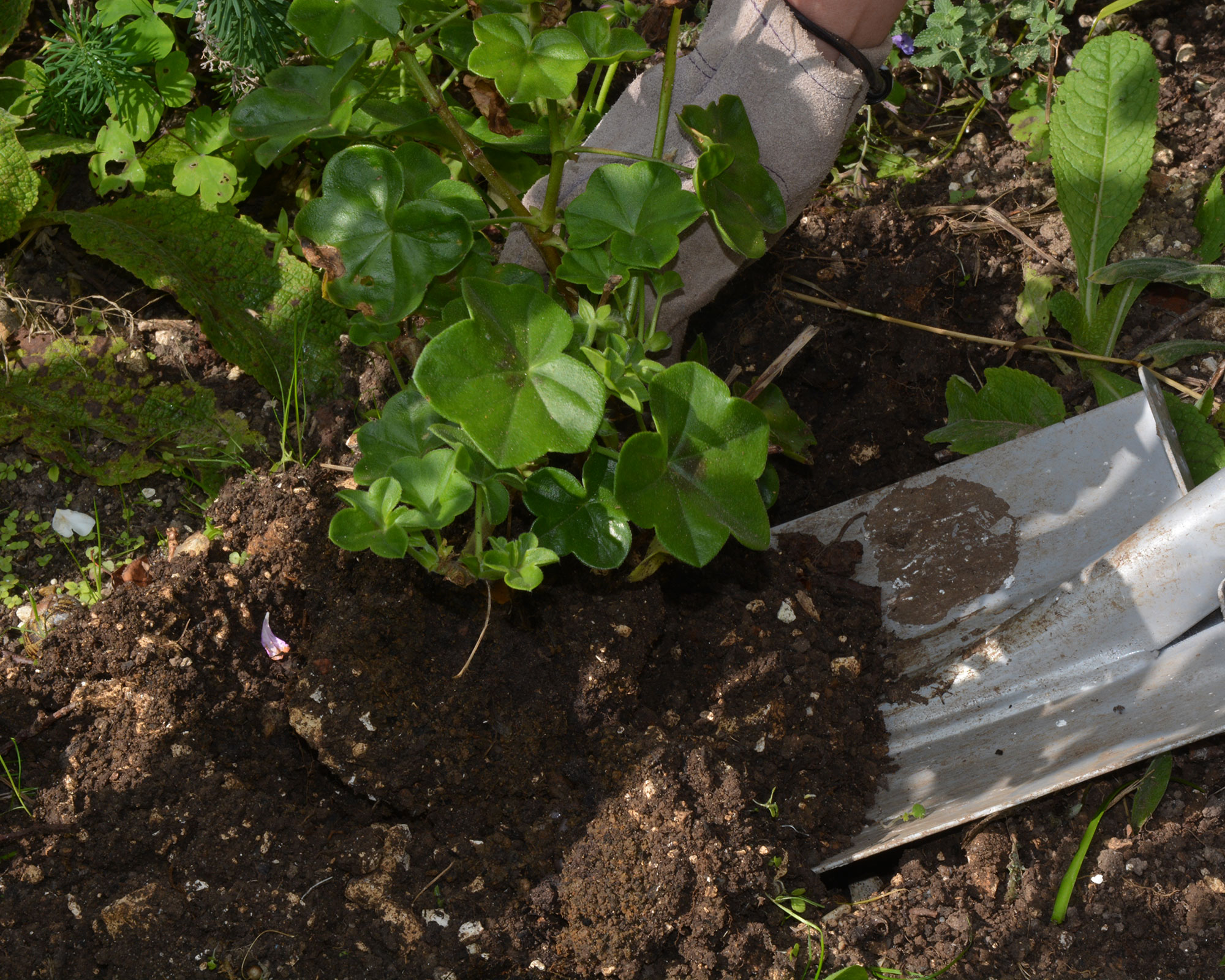
Digging up a pelargonium before potting it up and overwintering it undercover
As temperatures drop further it is time to move some of your tender perennials into the relative security of a greenhouse or cool porch.
Different plants have different requirements but pelargoniums and gazanias that are fairly small can be potted up, cut back and overwintered undercover.
It is a simple procedure, so start by digging around your plant and lift it with soil still attached to the roots. Place your plant in a container large enough to take all the roots, and fill with peat-free multipurpose compost.
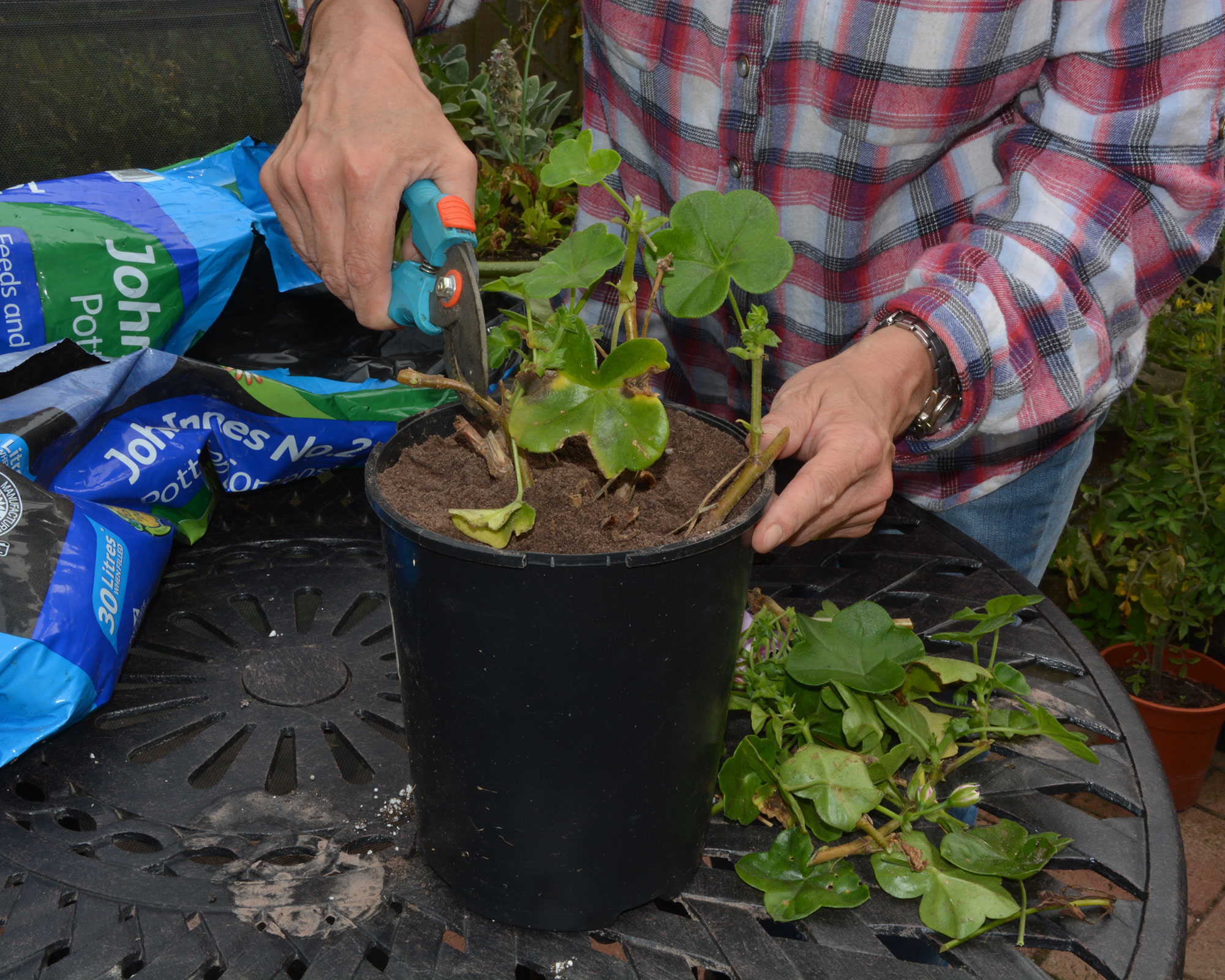
Cutting back pelargonium stems to 4in (10cm) before winter
Deadhead and, in the case of pelargoniums, reduce all the fleshy stems to around 3-4in (7-10cm) then water and place somewhere light and frost free.
To protect plants from frost, keep fleece handy to drape over tender plants on nights when the temperature falls well below 32˚F (0˚C).
Top tip: If any flower buds form during unseasonal mild spells in winter, pinch them out to prevent the plant wasting energy on flowers rather than strong new growth in spring.
8. Make your own leaf mold
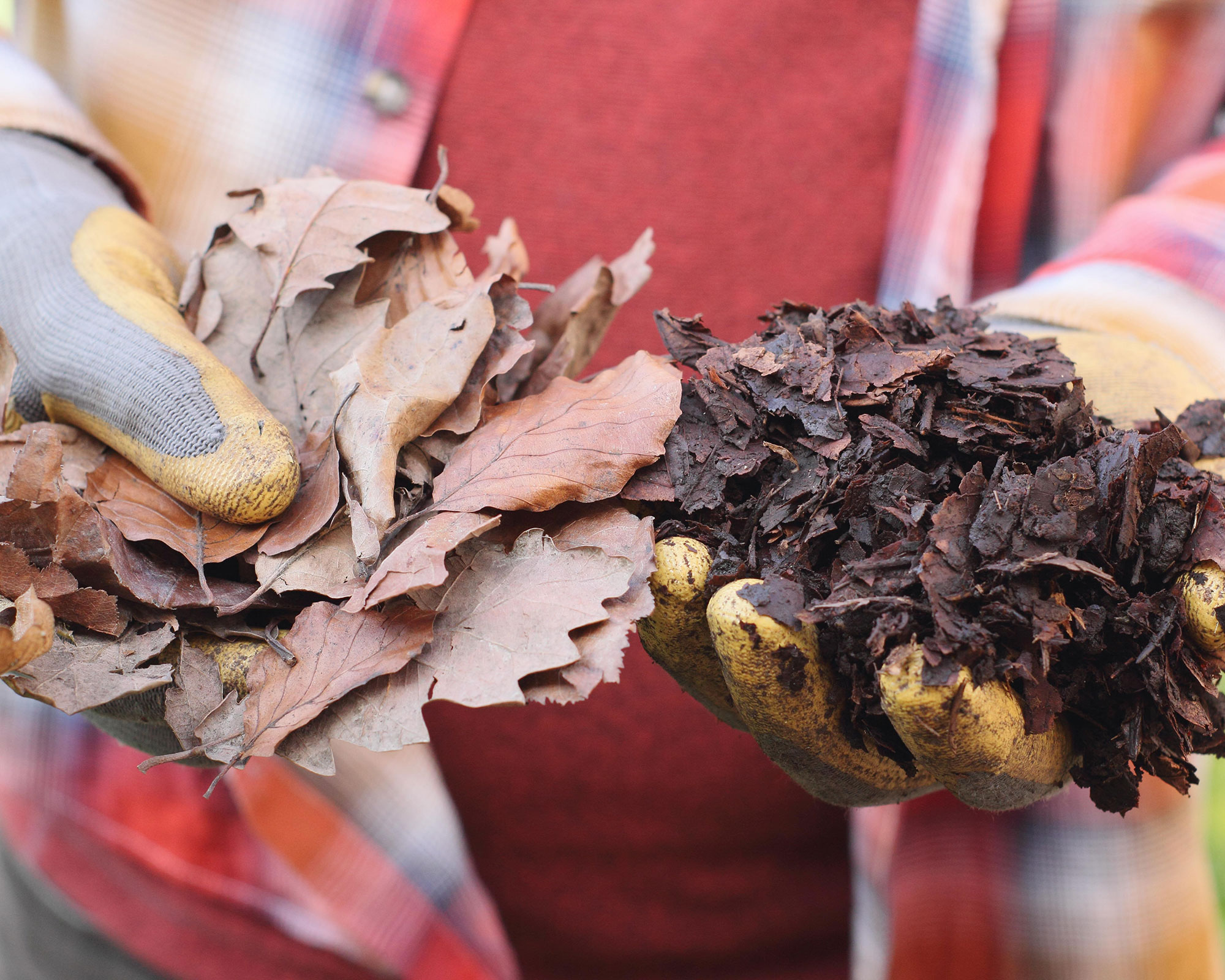
Fresh fallen leaves and leaf mold that has taken a couple of years to rot down
Every season has its associated chores and one of the key October gardening jobs is cleaning up leaves to make one of the most important commodities in soil improvement: leaf mold.
Learning how to make leaf mold with fallen leaves will improve your garden. It removes them from hard surfaces where they become dangerous and slippery as they degrade, and from the lawn where, if left, they can cause yellowing of grass and harbor pests and other problems.
Deciduous leaves have different properties and decompose at differing rates. The quickest and best are beech, oak and hornbeam.
Thicker leaves such as sycamore, walnut and those in the chestnut family take longer to break down, though you can speed up the process by shredding them or going over them with a lawn mower before collection.
These denser leaves can also be added to the compost heap after shredding.

Wetting leaves in a bin liner before setting them aside for a couple of years to turn into leaf mould
There are two main ways of storing leaves. You can construct a permanent bin using four tree stakes wrapped around with wire mesh. Alternatively, get black plastic bin liners, make holes in them and stuff them full of leaves.
Sprinkle some water in it before knotting the tops and stowing them somewhere out of the way. It will take at least two years for your leaves to rot down, but the end results will be nutritious, crumbly dark leaf mould.
If it is taking longer, turn the leaves occasionally and dampen them during long, dry spells.
Top tip: Save fallen pine needles and use them as a mulch around plants that like acidic soil, such as azaleas, blueberries and rhododendrons.
9. Cut back hardy perennials
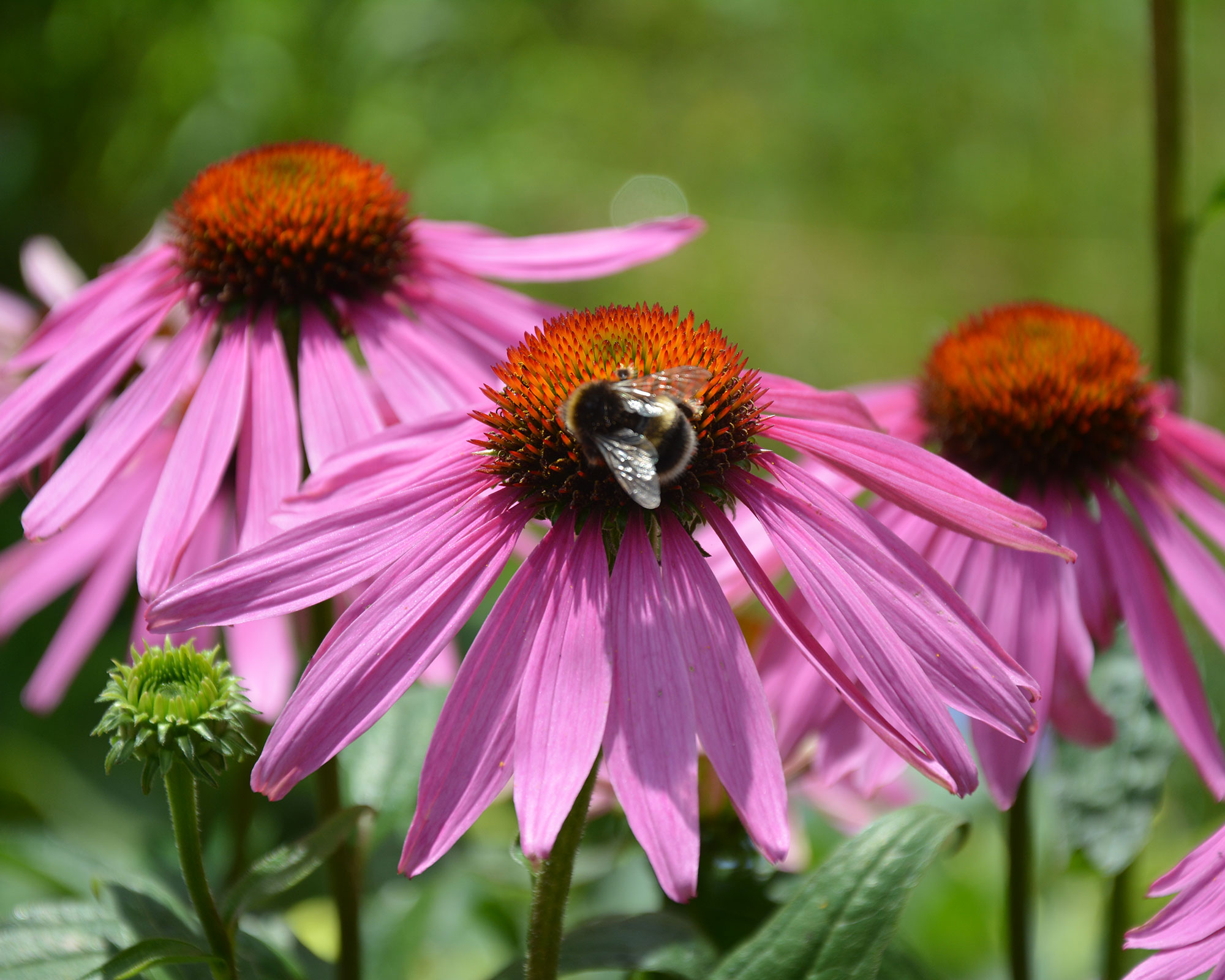
Hardy perennials such as echinacea can be cut back now
Perennial plants that are hardy enough to withstand winter in the garden should be cut back now as part of your October gardening jobs to keep them tidy and reduce the amount of plant material potentially at risk from frost.
Remove dead stems and flowerheads as well as leaves that have been left torn and battered after summer. You may choose to leave some stems intact however, and we recommend you do for a couple of reasons.
Architectural seedheads such as agapanthus, fennel and teasel are attractive in their own right and look marvellous in garden borders when they are touched by frost on sub-zero winter mornings.
Moreover, their seeds provide vital nourishment for birds at the hungriest time of the year, while their hollow stems can offer shelter for hibernating insects and invertebrates. There's plenty more ideas for how to attract birds into your garden in our guide too.

Male bullfinch sitting on frozen teasel head in winter
It's worth noting that not all perennials should be cut right down, however. Penstemons are not as hardy as many varieties so simply reduce this year’s growth by a third, removing spent flowerheads and a short length of stem.
The remaining stems will help protect the crown from the worst of winter’s chill. You can help your plant even more by layering a generous amount of well-rotted compost or manure over the root area.
Top tip: Save and dry some of the more attractive seedheads and spray them gold to use as Christmas decorations.
10. Don't neglect your roses

Roses often flower well into fall, especially in milder areas
If you've been following our advice on how to grow roses, don't stop the good work now the main flowering season is over. Roses need some care now, though with any luck they will keep flowering for a few more weeks yet, especially those in sheltered spots.
Start by deadheading flowers and remove and bin or burn any leaves that have succumbed to black spot, a fungal disease that is extremely common on roses.
Rose black spot can be identified by the yellow and black spots that proliferate on leaves and, in very bad cases, stems. Severe infections will lead to leaf-drop and weakened plants.
It is too late in the season to treat the problem with a fungicide, but you can help ensure it doesn’t linger by scooping up and, again, disposing of any fallen leaves with black spot, and mulching around your plant. This will smother any black spot spores that are lurking in the soil and help prevent them being splashed back onto the rose when it rains.
Top tip: Leave some dead flowers to form rose hips. They will add color to your winter garden ideas and the birds will feed on them too.
11. Look after your agapanthus

Agapanthus need care to get them through cold winters
If you've already learned how to grow agapanthus, chances are you already know they originate in South Africa and will therefore need a bit of care to see them through cold winters.
The evergreen varieties are slightly less hardy than deciduous plants, but should survive if given enough insulation and protection.
Whether they keep or lose their leaves, plants growing in the soil should be generously mulched with well-rotted manure, compost or straw.
The leaves of evergreens can be folded over and tied in a bunch to protect the crown, while deciduous agapanthus leaves should be left on the plant to die back.

Mulching an agapanthus growing in a border with a commercial organic mulch
If you've been growing evergreen agapanthus in pots as part of your container gardening ideas, they should be moved into a frost-free greenhouse or porch and mulched with compost.
You can do the same with deciduous varieties or, if your garden is reliably sheltered, move the pots against a sheltering wall, wrap with fleece and bubble wrap and tip them onto their side. This will ensure that the compost doesn’t get waterlogged during winter, as this would force oxygen out of the compost, drowning the roots.
Waterlogging can also risk cracking the pot should the saturated compost freeze and expand.
Top tip: Consider clustering several containers of plants together somewhere sheltered through winter so they are easier to insulate en masse
12. Protect banana plants
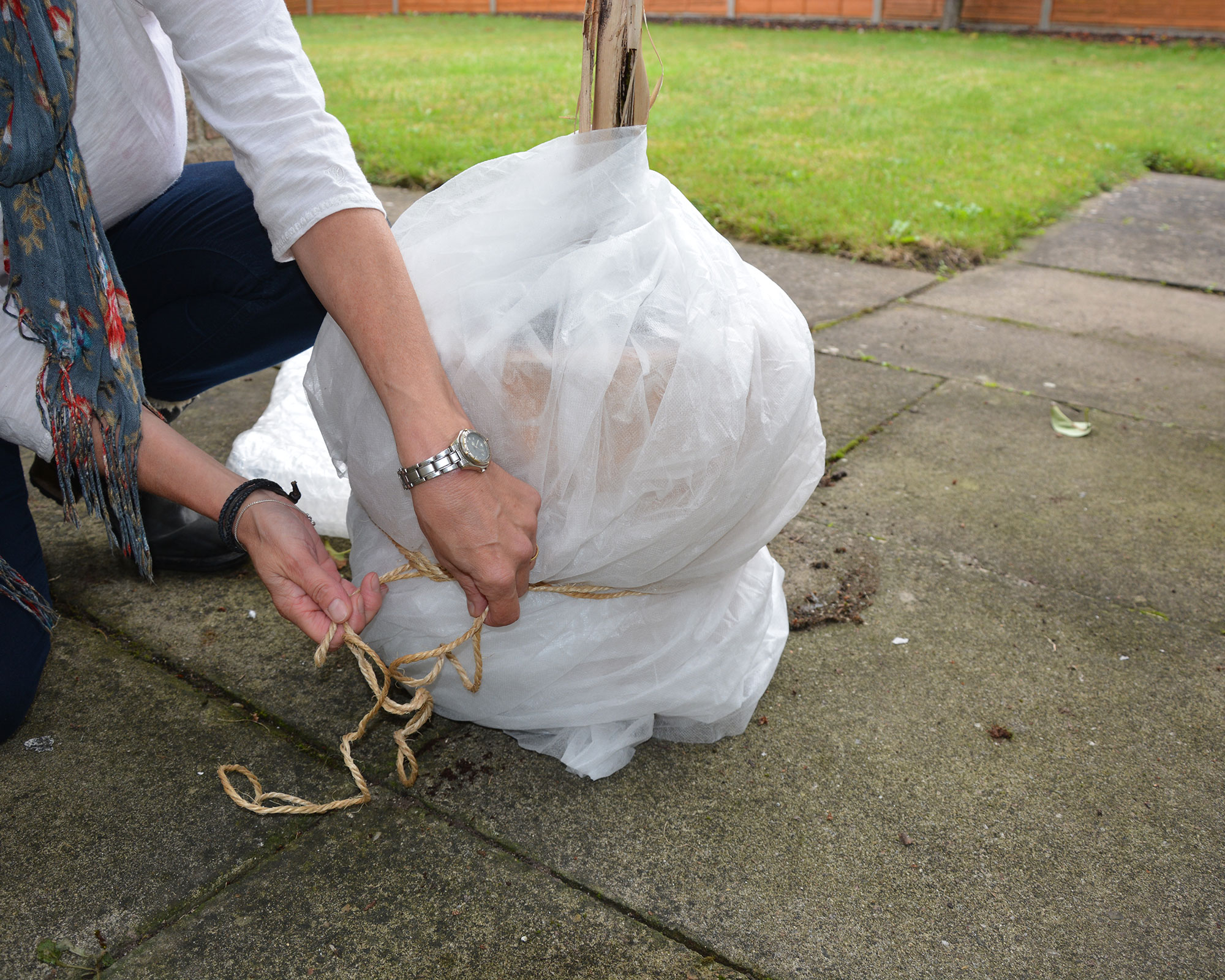
Wrapping a potted banana in fleece before winter
Potted bananas are another tender tropical plant that needs extra care through winter in colder regions, so one of your October gardening jobs should be to prepare these plants for cooler weather.
The hardiest variety, Musa basjoo, will survive as long as the top growth is cut back to around 3ft (1m) before the plant is mulched and its pot swaddled in fleece and bubblewrap. Move the pot somewhere sheltered and make sure its wrapping stays in place through winter.
Tender varieties such as Ensete are more likely to survive the cold seasons if moved undercover to somewhere well-lit and frost free. Remove their leaves as before and check they do not become infested by pests or hit by disease through winter.
Top tip: If your insulated potted banana stays somewhere sheltered outside for winter, raise it up on feet so excess rainwater can drain away.
13. Add pruning to your list of October jobs

Autumn is the ideal time to keep trees shapely and productive and remove dead branches
Late fall and winter are the peak pruning season for most deciduous trees and shrubs, so it is time to start sharpening and cleaning your best secateurs and best loppers and looking at your plants to see what needs doing.
By making pruning one of your October gardening jobs, it will help keep plants in good shape and encourage improved flowering and fruiting the following year. It also gives gardeners the opportunity to remove dead and damaged material and give trees a close inspection to make sure they are in good health.
One word of caution though. It will be extremely tempting to use all those woody prunings to make a bonfire, especially in the UK with November 5 coming around. If you have piled wood up ready to light, please move it again on the day of lighting, as an unsuspecting hedgehog may have already taken up hibernation residence inside.
Top tip: If you're considering when to prune fruit trees, do not prune plum or cherry trees in winter as the timing will make them more susceptible to silver leaf disease. Evergreens should also be pruned in summer as the cold can damage cut shoots.
14. Build a bug hotel
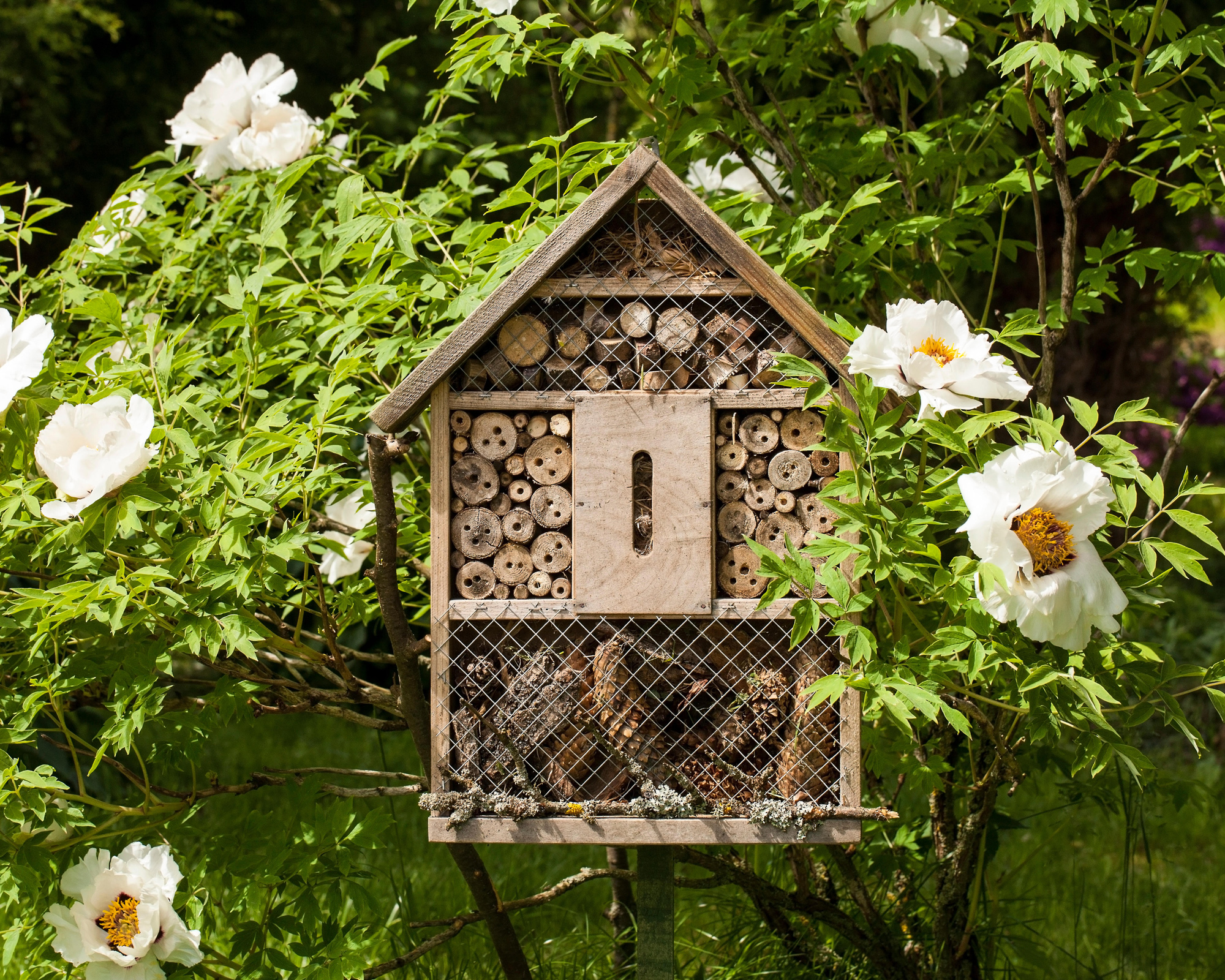
October is a great time to learn how to make a bug hotel as it will provide shelter for creepy crawlies during the cold months and they can be put together quickly and easily.
Simply stack shelves using wood offcuts and old bricks. Fill sections with bamboo tubes, pine cones, straw and leaves. In fact most natural material foraged from your garden will work well. Painting it in a bright color will make it a fun feature, too.
15. Treat your tools

You might not be seeing as much of your tools in the coming months but give them a good cleaning before they bed down for the season. Scrape mud off garden spades, forks and hoes.
If the mud is caked on then dunk them in warm, soapy water and wipe them down with an old towel or cloth. Rub oil (any type will do) onto the metal blades before putting them away in your garden tool storage for the rest of winter.

Ruth is the gardening editor of Amateur Gardening magazine and spends her working days carrying out, writing about and photographing the tasks the readers should be carrying out each week, as well as testing many of the new products that arrive on the gardening market. She is horticulturally trained, with a qualification from the Royal Horticultural Society.
